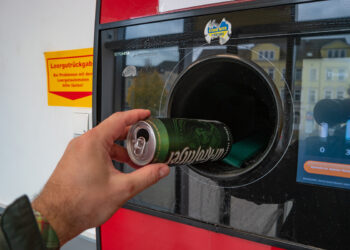Industry representatives shared concerns about PCR requirements, wine bottle labeling rules and how to handle plastic bladder bags inside beverage boxes during an Oct. 29 informal rulemaking workshop on California’s SB 1013.
The law, signed in 2022, brought wine and liquor bottles into the California Refund Value system along with wine and spirits in a box, bladder, pouch or similar container. It also added market development incentives.
The workshop, held by the California Department of Resources Recycling and Recovery, is the second and final informal rulemaking the agency will hold before moving into formal rulemaking starting in January. Final regulations are slated to be adopted in early 2026 after several rounds of formal public comment and revision.
Jeanette Barnard, a CalRecycle senior staff attorney, discussed some of the requested changes from the last informal hearing and why – or why not – the agency acted on them.
One that received many comments was the current requirement that each “bag in box” in a load of containers “shall be intact for the load to be eligible for the refund value,” when delivered both to a recycling center and to the processor. “Intact” means that the plastic bag inside the box is still inside and remains connected to the pouring valve.
Commenters had previously asked for that “intact” requirement to be removed, but Barnard said CalRecycle didn’t change the requirement because it would affect the payment rate, which is based on the full weight of the container.
Tim Schmelzer, vice president of California state relations at the Wine Institute, commented again that his organization believes that allowing the bags to be separated from the box would be a boon to both recyclers and consumers. He suggested printing the CRV information on the plastic bladder itself, then instructing consumers to separate the bag from the box at home so the box can go into curbside recycling.
“Spacewise, we think this will be helpful to the recycling centers and also more convenient for the consumer as well,” he said.
Other changes included a clarification that plastic portions of the newly added container types are indeed subject to PCR requirements set out in AB 793, even if they are not formally classified as a plastic beverage container – for example, the plastic bags in boxes will be subject to the PCR requirements.
And for consumer payments based on hand counts, the draft rules note that consumers can be paid based on count for up to 25 of the new container types, as opposed to the 50-container limit for beverage containers already in the program.
In addition, the draft clarifies that those caps are per transaction, not per day, though “a recycling center is not required to process more than one consecutive transaction for an individual consumer redeeming by count if there is one or more other consumers waiting to redeem empty beverage containers at the recycling center.”
Labeling, especially machine readable labeling such as QR codes, also received a significant amount of attention.
The draft rules first allowed more flexibility about where the CRV mark can be placed. Now it can be added to the bottom of metal cans. For glass or plastic containers, metal bottles and all of the newly added containers, the mark can be on the container body or on the label.
Barnard noted that because this flexibility is new, CalRecycle is very open to revising it and is specifically seeking comments around the labeling. The section on machine readable labeling was “substantially revised” between drafts, Barnard said, as the agency received a lot of public comment on it.
The first draft of rules allowed a QR code to be used in place of traditional labeling, and many commenters asked for that to be changed to “in addition to,” not “in replacement of.” However, CalRecycle decided not to make that change, Barnard said.
“The purpose of the machine readable labeling is to allow beverage containers to use a standardized label across states,” she said.
Changes the agency made include deleting a provision that made containers with a broken machine readable indicia ineligible for the refund value, because of concerns that recycling center employees would have to hand-scan each code. That raised questions of equity for rural centers, which may not have strong internet access or would have to provide all employees with smart devices to scan with.
Instead, employees would just have to complete a “visual inspection” to confirm that a QR code was present. Veronica Pardo, who is also a member of the SB 54 advisory board, spoke for the Resource Recovery Coalition of California and noted that she appreciated the adjustment.
Finally, the required size for QR code was increased to three-fourths of an inch instead of half, and the requirement to have a chasing arrows symbol in the QR was replaced with a requirement to have the word “deposit” visible near the code.






















